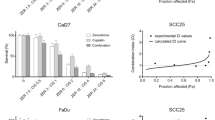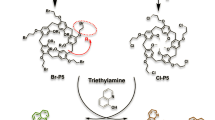Abstract
Background and purpose
Cafestol is a diterpene molecule found in coffee beans and has anticarcinogenic properties. The aim of the study was to examine the effects of cafestol in head and neck squamous cell carcinoma (HNSCC) cells.
Materials and methods
Three HNSCC cell lines (SCC25, CAL27 and FaDu) were treated with increasing doses of cafestol. Then combination experiments with cisplatin and irradiation were carried out. Drug interactions and possible synergy were calculated using the combination index analysis. Clonogenic assays were performed after irradiation with 2, 4, 6 and 8 Gy, respectively, and the rate of apoptosis was measured with flow cytometry.
Results
Treatment of HNSCC cells with cafestol leads to a dose-dependent reduction of cell viability and to induction of apoptosis. Combination with irradiation shows a reduction of clonogenic survival compared to each treatment method alone. In two of the cell lines a significant additive effect was observed.
Conclusion
Cafestol is a naturally occurring effective compound with growth-inhibiting properties in head and neck cancer cells. Moreover, it leads to a significant inhibition of colony formation.
Zusammenfassung
Hintergrund und Ziel
Cafestol ist ein Diterpen, das in der Kaffeebohne vorkommt und antikanzerogene Eigenschaften besitzt. Ziel der Studie war, die Wirkung von Cafestol auf Kopf-Hals-Tumorzelllinien zu untersuchen.
Material und Methodik
Drei Kopf-Hals-Tumorzelllinien (SCC25, CAL27 und FaDu) wurden mit steigenden Cafestol-Dosen behandelt. Anschließend fanden Kombinationsexperimente mit Cisplatin und Bestrahlung statt. Die Wechselwirkung zwischen den Substanzen und mögliche synergistische Wirkungen wurden mit dem Combination-Index analysiert. Koloniebildungstests wurden nach Bestrahlung mit 2, 4, 6 und 8 Gy durchgeführt. Apoptose wurde mittels Durchflusszytometrie gemessen.
Ergebnisse
Die Behandlung der Kopf-Hals-Tumorzelllinien mit Cafestol führt zu einer dosisabhängigen Abnahme des Zellüberlebens und zur Induktion von Apoptose. Die Kombination von Cafestol mit Bestrahlung zeigt eine geringere Koloniebildung verglichen mit den einzelnen Behandlungsmethoden. In 2 Zelllinien konnten wir einen signifikanten additiven Effekt nachweisen.
Schlussfolgerung
Cafestol ist ein natürlich vorkommender, effektiver und vielversprechender Wirkstoff mit wachstumshemmenden Eigenschaften in Kopf-Hals-Tumorzelllinien. Zudem führt er zu einer signifikanten Inhibition der Koloniebildung.





Similar content being viewed by others
References
Breitmaier E (2006) Terpenes. Wiley - VCH Verlag GmbH & Co. KGaA, Weinheim, Germany
Cavin C, Holzhaeuser D, Scharf G, Constable A, Huber WW, Schilter B (2002) Cafestol and kahweol, two coffee specific diterpenes with anticarcinogenic activity. Food Chem Toxicol 40:1155–1163
Choi MJ, Park EJ, Oh JH et al (2011) Cafestol, a coffee-specific diterpene, induces apoptosis in renal carcinoma Caki cells through down-regulation of anti-apoptotic proteins and Akt phosphorylation. Chem Biol Interact 190:102–108
Chou T-C (2006) Theoretical basis, experimental design, and computerized simulation of synergism and antagonism in drug combination studies. Pharmacol Rev 58:621–681
Corry J, Peters LJ, Rischin D (2010) Optimising the therapeutic ratio in head and neck cancer. Lancet Oncol 11:287–291
Eder-Czembirek C, Erovic BM, Czembirek C et al (2010) Betulinic acid a radiosensitizer in head and neck squamous cell carcinoma cell lines. Strahlenther Onkol 186:143–148
Ferlay J, Shin H-R, Bray F, Forman D, Mathers C, Parkin DM (2010) Estimates of worldwide burden of cancer in 2008: GLOBOCAN 2008. Int J Cancer 127:2893–2917
Franken NAP, Rodermond HM, Stap J, Haveman J, van Bree C (2006) Clonogenic assay of cells in vitro. Nat Protoc 1:2315–2319
González-Vallinas M, González-Castejón M, Rodríguez-Casado A, Ramírez de Molina A (2013) Dietary phytochemicals in cancer prevention and therapy: a complementary approach with promising perspectives. Nutr Rev 71:585–599
Haddad RI, Shin DM (2008) Recent advances in head and neck cancer. N Engl J Med 359:1143–1154
Harvey A (2008) Natural products in drug discovery. Drug Discovery Today 13:894–901
Heiduschka G, Lill C, Seemann R et al (2014) The effect of resveratrol in combination with irradiation and chemotherapy: study using Merkel cell carcinoma cell lines. Strahlenther Onkol 190:75–80
Joseph B, Vishwanath L, Venugopal BK (2014) Radiosensitization in head and neck cancer: do we have an alternative to platins? Role of taxanes. Oral Surg Oral Med Oral Pathol Oral Radiol 117:324–328
Kotowski U, Heiduschka G, Brunner M et al (2011) Radiosensitization of head and neck cancer cells by the phytochemical agent sulforaphane. Strahlenther Onkol 187:575–580
Lee K-A, Chae J-I, Shim J-H (2012) Natural diterpenes from coffee, cafestol and kahweol induce apoptosis through regulation of specificity protein 1 expression in human malignant pleural mesothelioma. J Biomed Sci 19:60
Mishra BB, Tiwari VK (2011) Natural products: an evolving role in future drug discovery. Eur J Med Chem 46:4769–4807
Molinari G (2009) Natural products in drug discovery: present status and perspectives. Adv Exp Med Biol 655:13–27
Nambiar D, Rajamani P, Singh RP (2011) Effects of phytochemicals on ionization radiation-mediated carcinogenesis and cancer therapy. Mutat Res 728:139–157
Rahman MA, Amin ARMR, Shin DM (2010) Chemopreventive potential of natural compounds in head and neck cancer. Nutr Cancer 62:973–987
Tribius S, Sommer J, Prosch C et al (2013) Xerostomie nach Strahlentherapie. Strahlenther Onkol 189:216–222
Trotti A (2000) Toxicity in head and neck cancer: a review of trends and issues. Radiat Oncol Biol 47:1–12
Urgert R, Katan MB (1996) The cholesterol-raising factor from coffee beans. J R Soc Med 89:618–623
Author information
Authors and Affiliations
Corresponding author
Ethics declarations
Conflict of interest
U. Kotowski, G. Heiduschka, R. Seemann, J. Eckl-Dorna, R. Schmid, V. Kranebitter, I. Stanisz, M. Brunner, C. Lilland D. Thurnher state that there are no conflicts of interest.
The accompanying manuscript does not include studies on humans or animals.
Rights and permissions
About this article
Cite this article
Kotowski, U., Heiduschka, G., Seemann, R. et al. Effect of the coffee ingredient cafestol on head and neck squamous cell carcinoma cell lines. Strahlenther Onkol 191, 511–517 (2015). https://doi.org/10.1007/s00066-014-0807-x
Received:
Accepted:
Published:
Issue Date:
DOI: https://doi.org/10.1007/s00066-014-0807-x




